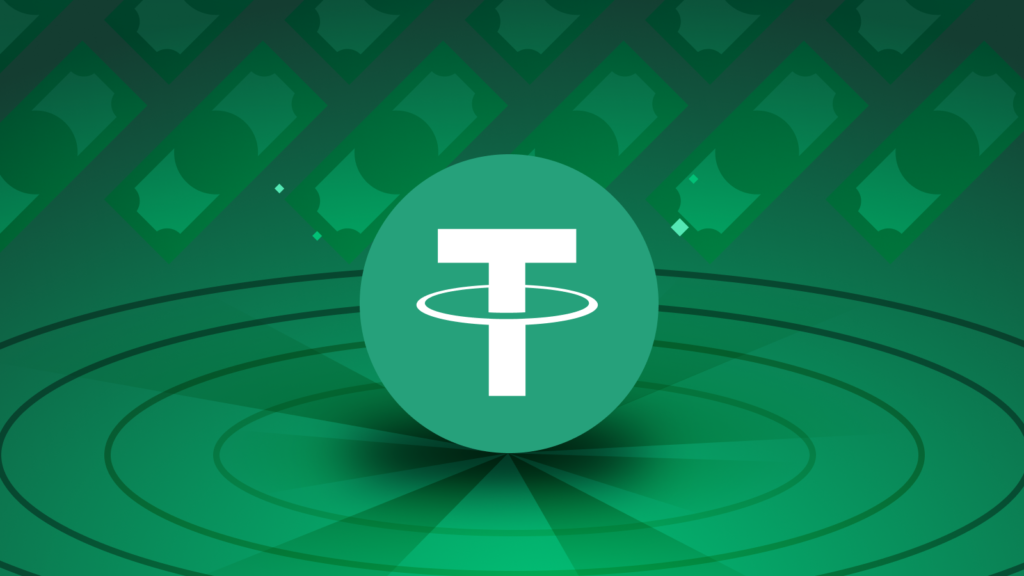Explore Tether (USDT)’s vital role in the cryptocurrency market, including its price stability, origins, advantages, and impact on trading and decentralized finance.
Tether (USDT) is one of the most well-known stable coins in the cryptocurrency world. Its primary purpose is to maintain a stable value by pegging itself to the US dollar. But how did Tether come to be, and why is it so important in the crypto space? This article delves into the origins, history, and significance of Tether, along with its advantages, market role, and frequently asked questions. Let’s explore the world of USDT and discover what makes it stand out in a sea of digital currencies.
What is Tether (USDT)?
Definition of Tether (USDT)
Tether (USDT) is a cryptocurrency designed to maintain a 1:1 peg with the US dollar, offering stability in a highly volatile crypto market. Unlike Bitcoin or Ethereum, which experience wild price swings, Tether’s value remains constant, making it ideal for traders and investors looking for a safer option to store their funds.
USDT is classified as a stablecoin because it’s backed by reserves that include cash or cash equivalents. The company behind Tether, Tether Limited, ensures that every USDT token issued is backed by assets in its reserves, keeping the value of the token stable.
How Tether Maintains Stability
Tether operates on a simple yet powerful mechanism: maintaining a reserve for every USDT in circulation. When users buy Tether, the equivalent amount of USD or other reserve assets is held in storage by the issuer. This backing guarantees the stability of Tether, even when the broader cryptocurrency market faces turbulence.
The stability offered by Tether is one of its biggest advantages. Since each Tether token is backed by real-world assets, it provides a reliable store of value, shielding investors from the unpredictable volatility seen in most cryptocurrencies.
The Story of Tether (USDT)
Origins of Tether
Tether was first launched in 2014 under the name “Realcoin.” The initial idea was to create a cryptocurrency that would combine the benefits of digital currencies with the stability of fiat money. Soon after, Realcoin rebranded as Tether, with the ticker symbol USDT, marking the beginning of its journey as a stablecoin.
The goal was straightforward: provide a digital asset that could maintain its value over time, allowing people to move in and out of cryptocurrencies without exposure to price volatility. Tether emerged as one of the first projects to bridge the gap between traditional financial systems and blockchain technology.
Early Adoption and Use Cases
Initially, Tether gained traction among crypto traders who needed a stable asset to hedge their investments. It was mainly used as a tool to move in and out of different cryptocurrencies without converting back to fiat currencies, which often involved long delays and high transaction fees.
Crypto exchanges quickly adopted Tether, seeing its potential as a stable trading pair. This allowed users to trade cryptocurrencies in terms of dollars without needing a bank account, thus expanding access to the global trading community.
Evolution of Tether Over the Years
Since its inception, Tether has experienced massive growth. By 2020, it had become one of the most traded digital assets in the world. Beyond trading, Tether found new use cases in decentralized finance (DeFi), remittances, and even as a store of value during times of market uncertainty.
Tether has expanded across multiple blockchains, including Ethereum, Tron, and Binance Smart Chain, to facilitate faster and cheaper transactions. Despite facing regulatory scrutiny and controversies, Tether remains a cornerstone of the cryptocurrency ecosystem.
History Behind Tether (USDT)

The Birth of Stablecoins
Tether was a pioneer in the stablecoin market, which has since grown to include various other projects. Stablecoins were created to mitigate the risk of price volatility, offering the advantages of cryptocurrencies (speed, global reach, decentralization) without their significant price swings.
The success of Tether paved the way for other stablecoins, but USDT continues to dominate the market in terms of trading volume and market cap.
Tether’s Role in Cryptocurrency Markets
Tether plays a crucial role in providing liquidity to the cryptocurrency market. As the most widely used stablecoin, it facilitates billions of dollars in daily trading volume. Many traders use Tether as a “safe haven” during periods of high volatility. By converting their assets into USDT, they can avoid the extreme price fluctuations of other cryptocurrencies.
USDT also enables seamless cross-border transactions, making it an attractive option for traders and businesses alike.
Controversies and Regulatory Scrutiny
Despite its widespread adoption, Tether has faced significant controversy. Critics have questioned whether Tether is fully backed by reserves, as the company behind USDT has faced legal challenges and regulatory scrutiny over its lack of transparency.
In 2021, Tether Limited reached a settlement with the New York Attorney General’s office regarding the transparency of its reserves. While Tether has since published regular attestations of its reserve holdings, concerns about its long-term stability remain a topic of debate in the cryptocurrency community.
Advantages of Tether (USDT)

Stability and Low Volatility
One of the main selling points of Tether is its stability. Unlike most cryptocurrencies that can experience large price swings, USDT maintains a stable value, making it an attractive option for users looking to avoid the volatility of the crypto market.
This stability is particularly useful for businesses and traders who need a reliable means of exchange. Tether’s stability ensures that users can confidently store and transfer value without the risk of sudden price drops.
Bridging Traditional Finance and Crypto
Tether serves as a bridge between traditional financial systems and the world of cryptocurrencies. Businesses can accept Tether for payments and instantly convert it to US dollars, avoiding the delays and costs associated with traditional banking systems.
This seamless transition between fiat and digital assets is one of the key reasons behind Tether’s widespread adoption.
Fast Transactions and Liquidity
Transactions involving Tether are much faster than traditional banking systems, making it ideal for cross-border payments. Tether is also highly liquid, meaning it’s easy to trade or exchange for other cryptocurrencies or fiat currencies, adding to its popularity among traders.
Widespread Acceptance
Tether is accepted by numerous cryptocurrency exchanges, wallets, and platforms, making it easy for users to trade, invest, and transact in USDT. This widespread acceptance is one of the reasons why Tether is one of the most trusted stablecoins in the market.
The Market and Role of Tether (USDT)
How Tether is Used in Cryptocurrency Trading
In the world of cryptocurrency trading, Tether acts as a stable intermediary. Traders often use USDT to hedge against volatility, lock in profits, or move in and out of positions without cashing out to fiat currency. This makes Tether an essential tool for managing risk in the volatile crypto market.
Tether as a Safe Haven During Market Volatility
During times of market turbulence, many crypto traders turn to Tether as a safe haven. By converting their assets into USDT, they can avoid the drastic price swings of other cryptocurrencies, parking their funds in a stable asset until the market stabilizes. This makes Tether a valuable tool for risk management in the world of crypto trading.
Tether in Decentralized Finance (DeFi)
Tether has also found a significant role in the decentralized finance (DeFi) space. Many DeFi protocols use USDT as collateral for loans, liquidity pools, and other financial instruments. Its stability and liquidity make it an ideal asset for these use cases, driving its adoption within the DeFi ecosystem.
Challenges and Criticisms of Tether (USDT)
Lack of Transparency
One of the biggest criticisms against Tether is its lack of transparency regarding its reserves. While the company claims that every USDT is fully backed by reserves, it has faced legal challenges and skepticism from regulators and market participants about the actual assets held in its reserve.
Regulatory Challenges
Tether has faced significant regulatory scrutiny, particularly in the United States. Various regulatory bodies have questioned the company’s transparency and practices, leading to lawsuits and fines. Despite these challenges, Tether remains resilient and continues to play a key role in the crypto ecosystem.
FAQs about Tether (USDT)
Is Tether Truly Backed by US Dollars?
Tether claims that every USDT is backed by an equivalent amount of assets, including US dollars and other cash equivalents. However, the exact composition of these reserves has been the subject of debate and scrutiny.
Why is Tether Important in Crypto Trading?
Tether provides stability in a volatile market. It allows traders to park their funds in a stable asset without having to convert them back to fiat, offering liquidity and risk management tools.
How Can I Buy and Use Tether?
Tether can be bought and sold on most major cryptocurrency exchanges. Users can purchase Tether with fiat currency or other cryptocurrencies, and use it for trading, saving, or transferring value globally.
Can Tether’s Value Drop Below $1?
While Tether is designed to maintain a 1:1 peg with the US dollar, there have been brief instances where its price has deviated slightly. These fluctuations are usually minor and corrected quickly due to market forces.
What is the Future of Tether?
Despite facing controversies and regulatory scrutiny, Tether remains a dominant player in the cryptocurrency space. Its future depends on how well it can maintain transparency and adapt to the evolving regulatory landscape.
Conclusion
Tether (USDT) has revolutionized the cryptocurrency market by providing a stable, reliable digital asset. Its widespread use in trading, DeFi, and as a bridge between fiat and crypto highlights its importance in the global financial ecosystem. Despite facing challenges and criticisms, Tether continues to hold its ground as one of the most traded and trusted stablecoins. As the crypto space evolves, Tether will likely remain a key player, offering stability in an otherwise volatile market.
For More Information, https://coinfxnews.com/




